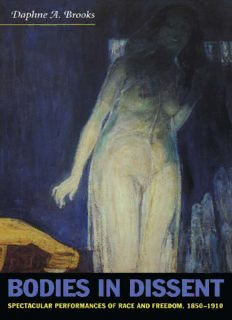
Bodies in Dissent: Spectacular Performances of Race and Freedom, 1850–1910 PDF
Preview Bodies in Dissent: Spectacular Performances of Race and Freedom, 1850–1910
BODIES IN DISSENT BODIES IN DISSENT Spectacular Performances of Race and Freedom, 1850–1910 Daphne A. Brooks Duke University Press Durham and London 2006 ∫ 2006 Duke University Press All rights reserved Printed in the United States of America on acid-free paper $ Designed by Amy Ruth Buchanan Typeset in Minion by Keystone Typesetting, Inc. Library of Congress Cataloging-in- Publication Data and republication acknowledgments appear on the last printed page of this book. Duke University Press gratefully acknowledges the support of Princeton University, which provided funds toward the production of this book. For Juanita Kathryn Watson Brooks and in memory of Nathaniel Hawthorne Brooks, Sr. CONTENTS Acknowledgments ix Introduction 1 1. Our Bodies, Our/Selves 14 Racial Phantasmagoria and Cultural Struggle 2. The Escape Artist 66 Henry Box Brown, Black Abolitionist Performance, and Moving Panoramas of Slavery 3. ‘‘The Deeds Done in My Body’’ 131 Performance, Black(ened) Women, and Adah Isaacs Menken in the Racial Imaginary 4. Alien/Nation 207 Re-Imagining the Black Body (Politic) in Williams and Walker’s In Dahomey 5. Divas and Diasporic Consciousness 281 Song, Dance, and New Negro Womanhood in the Veil Epilogue 343 Theatre, Black Women, and Change Notes 349 Bibliography 417 Index 455 ACKNOWLEDGMENTS This project would have never been completed without the financial support of several institutions and the counsel and encouragement of advisers, men- tors, friends, and family during what, at times, seemed like an epic gestation period. As a dissertation, the project was funded generously by the Mellon Foundation, the University of California, Los Angeles, the Ford Foundation, and the W. E. B. Du Bois Institute for Afro-American Studies Research at Harvard University. Princeton University, the University of California, San Diego, the President’s Postdoctoral Fellowship from the University of Cali- fornia, Berkeley, and the Woodrow Wilson Foundation each financed my time away from teaching so that I could complete revisions of the manuscript. I am particularly grateful to the late Richard Newman, Lisa Thompson, the sta√ of the Du Bois Institute and the entire ‘‘Couch’’ writing collective (Farah Gri≈n, Guy Ramsey, Bill Lowe, and Salim Washington) for allowing me the oppor- tunity to spend time cultivating this project in its earliest stages and in the midst of an energetic and supportive scholarly community. Jane Gonzalez and the U.C. President’s Postdoctoral Fellowship sta√ provided helpful assistance to me during my two years of sabbatical research at the University of Califor- nia, Berkeley. Many thanks as well to Richard Hope, Sylvia Sheridan, and Bill Mitchell for organizing and overseeing the Woodrow Wilson’s vibrant and nurturing Career Enhancement Program for junior faculty which provided me with the necessary time to complete research on this project. A very special thanks to Ken Wissoker for his patience, steady support, and editorial vision and to Courtney Berger and the entire Duke University Press sta√ for oversee- ing the development of this project. Over the years, it has become apparent to me that an archivist’s best friend is her librarian. For their generous time and diligent resourcefulness, I would like to thank the wonderful library sta√s at the University of California, Berkeley’s Bancroft Library, Yale University’s Beinecke Rare Book and Manu-
Description: